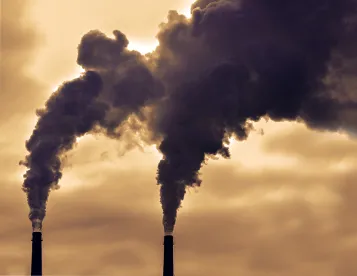May was a busy month for climate change activism. On May 15, 2015, JPMorgan Chase announced steps it was taking in its effort to align its financing activities with the climate goals of the Paris Agreement by use of its Carbon Compass Methodology, and set targets for the auto manufacturing, electric power, and oil and gas industries to reach a reduction in carbon “intensity” by 2030. Then on May 26, 2021, shareholders of Exxon Mobil elected two board candidates — and a third was later elected on June 2 — who intend to steer the company away from oil and gas and toward cleaner energy, and Chevron investors supported a resolution to further reduce its greenhouse gas (GHG) emissions — signaling that the American oil and gas industry may be ready to join its European counterpart in investing in energy sources that do not emit GHGs. That same day, a Dutch court ordered Shell to slash its carbon dioxide emissions by 45% by 2030.
As these events unfold in the private sector, there is renewed focus from the US federal government on identifying and establishing costs of GHGs to be used in analyzing and assessing policy decisions. Earlier this year, the Biden administration’s newly revived Interagency Working Group (IWG) on Social Cost of Greenhouse Gases announced new estimated interim values for the social costs of GHGs, with plans to formalize its assessment by early next year.
The IWG Is Revived and Sets Interim Costs of GHGs
In a stark reversal from the federal government’s consideration of the impacts of climate change during the previous administration, on Feb. 26, 2021, the Biden administration’s IWG announced new values for three specific metrics that seek to monetize the environmental impacts of GHGs: Social Cost of Carbon (SCC), Social Cost of Nitrous Oxide, and Social Cost of Methane. Under the Trump administration, these social costs were set at insignificant levels. President Biden’s Executive Order on Protecting Public Health and the Environment and Restoring Science to Tackle Climate Change (Jan. 20, 2021) (EO 13990) included a directive to re-establish the IWG. This article focuses on the SCC, which the IWG has calculated on an interim basis at $51 per metric ton (mt).
The Obama administration established the IWG, which uses various models and data to estimate the SCC. The SCC, which attempts to put a price on the long-term economic damage that results from a 1 metric ton increase in carbon dioxide in a year, was applied in a number of agency rulemakings and other actions. By the end of Obama’s presidency, the SCC was estimated at roughly $36/mt.
The Trump administration dismantled the IWG, and the SCC then fell to a range of $1/mt to $6/mt. As a result, the SCC was no longer a significant factor in agency regulatory activities. With the resetting of the SCC to a significant value, it will begin to again influence federal decision-making, and courts and states will also begin considering it in evaluating environmental impacts. Industry actors will need to pay close attention to how the new administration applies SCC and quickly adapt their activities accordingly.
On May 7, 2021, the Office of Management and Budget formally requested comments on the IWG’s interim estimates under EO 13990 for the social costs of GHGs. The next steps for the IWG are to provide recommendations to the president, by no later than Sept. 1, 2021, regarding areas of decision-making, budgeting, and procurement by the federal government where the social costs of GHGs should be applied; to publish final rules on GHG emissions, no later than January 2022; and to provide recommendations, by no later than June 1, 2022, regarding a process for reviewing, and, as appropriate, updating the social costs of GHGs to ensure that these costs are based on the best available economics and science. The IWG is also tasked with providing recommendations to revise methodologies for calculating the social costs of GHGs, to the extent that current methodologies do not adequately take account of climate risk, environmental justice, and intergenerational equity.
The Interim Costs of GHGs Will Have an Immediate Effect on Government Decision-Making
The revised calculation of the SCC will influence both federal- and state-level regulatory actions, including the cost-benefit analyses that government agencies undertake as part of permitting and rulemaking. In fact, federal agencies have already begun to incorporate the social costs of GHGs into their decision-making process. For example, the EPA recently published the final rule “Revised Cross-State Air Pollution Rule Update for the 2008 Ozone NAAQS.” This rule is designed to address interstate transport of ozone pollution under the “good neighbor provision” of the Clean Air Act. The EPA included data on the social costs of GHGs in its calculations on the economic impact of the regulation.
Later, the EPA proposed the “Phasedown of Hydrofluorocarbons: Establishing the Allowance Allocation and Trading Program Under the American Innovation and Manufacturing Act” rule. As the name suggests, the rule seeks to decrease production and consumption of hydrofluorocarbons. Again, when the EPA calculated the economic costs and benefits of the proposed rule, the benefits portion of the equation included different possible calculations of the future social costs of hydrofluorocarbons. These calculations were based on EO 13990’s interim figure.
EO 13990 is only a few months old, and the federal government often moves slowly. With this in mind, it is telling that multiple rules are already citing EO 13990 and utilizing the updated understanding of the SCC.
Litigation Is Underway
As expected, a dozen red states are suing to stop President Biden’s plans to increase the social cost of carbon and other GHGs, arguing government overreach. Meanwhile, other states are taking strong positions against GHG emissions. In late April, for example, Washington State enacted the Climate Commitment Act. The act creates a market-based, economy-wide, cap-and-trade program. Another piece of legislation (HB 1091) in the state creates a program to reduce carbon in transportation fuels. Washington State’s legislation goes even further than California’s cap-and-trade program by including an environmental justice component. Climate change efforts and environmental justice initiatives will inevitably align as both of these issues and their interplay gain wider recognition.
Legislation Introduced
On June 16, 2021, it was announced that Senators Sheldon Whitehouse (D-RI) and Brian Schatz (D-HI) are introducing legislation called the “Save Our Future Act,” intended “to drastically drive down the harmful emissions causing climate change and putting Americans’ health and the global economy at risk.” According to the announcement, the legislation will set the cost of carbon, for example, at $54/ton, beginning in 2023, consistent with the IWG estimate.
How Should Emitters React to the Social Costs of GHGs?
Now that carbon is no longer essentially “free,” companies that emit significant amounts of GHGs will need to rethink the value of carbon and how that cost factors into operations. There are a number of ways to do this, including factoring these costs into pricing determinations or developing new technologies to help reduce GHG emissions. The Biden administration is keenly focused on reductions of GHGs and will be incorporating that focus into an all-of-government approach using nontraditional means to achieve its goals. Setting costs for GHGs is one means to force reductions in GHGs by stimulating voluntary reduction efforts, encouraging innovation (likely by funding programs and tax breaks), and stimulating the conversion of energy resources away from fossil fuels over a shorter horizon than recently contemplated. We will see the costs of GHGs being applied in cost-benefit analyses performed in connection with regulatory assessments, in the funding of local infrastructure projects, in the consideration of alternative energy projects, and in the permitting of traditional fossil fuel projects like pipelines, plant expansions, etc.
These governmental efforts to focus on the costs of GHGs in setting policy and approving or rejecting new industrial projects, coupled with the private sector GHG-reducing initiatives, including those relating to access to capital funding and the resetting of corporate culture and policy, are to be closely watched.





 />i
/>i
